2013-2015 Highlights
2015
Undergraduate Haroon Khan in Washington DC for Posters on the Hill
On April 22-23, 2015, GWPAC undergraduate researcher Haroon Khan visited Washington DC to present his research to members of Congress as part of the Council for Undergraduate Research's prestigious Posters on the Hill program. Haroonwas selected as one of 60 from the entire US out of an applicant pool or more than 500 students. Haroon's poster focused on "Simulating colliding black holes for gravitaitonal wave astronomy," work that he is doing together with his research mentor, physics professor Geoffrey Lovelace.
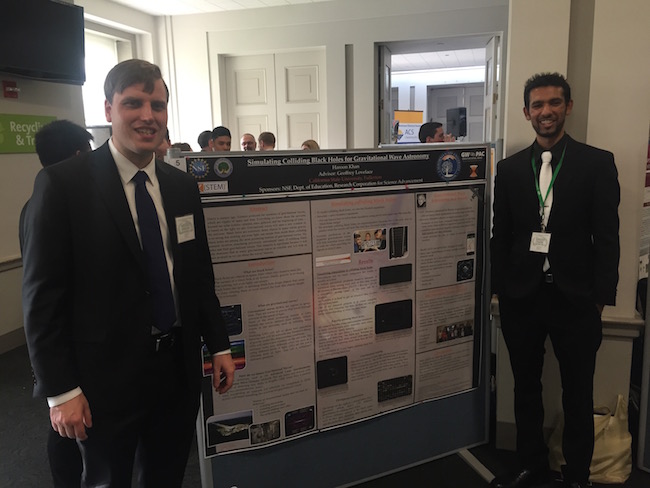
While in Washington, Haroon and Lovelace had the opportunity to meet with California's U.S. Representative Ed Royce (CA-39) and his staff, and with staff from the office of U.S. Representative Loretta Sanchez (CA-46) and from the office of U.S. Senator Dianne Feinstein. In addition, they visited the White House complex, saw congressional deliberations on the America Competes Act, and visited the Air and Space Museum.
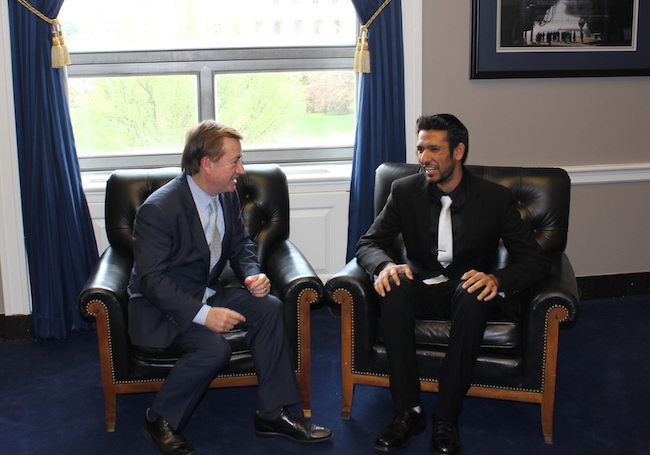
Haroon is the first student from the College of Natural Science and Mathematics and the second from California State University Fullerton to participate in Posters on the Hill. The first was psychology student Kevin Chavarria, who presented his research on "When Parents Are Twins: Double Look at Social Relations Within Families," together with faculty mentor Nancy Segalin 2007.
Haroon's work was supported by National Science Foundation grant PHY-1307489 and STEM^2 Department of Education grant P031C110116-12.
Congratulations Haroon and Geoffrey!
2014
GWPAC members attend SACNAS 2014 in LA
The 2014 SACNAS national conference was held in the LA Convention Center (right next to the Staples Center) in Downtown LA from October 16 to 18. The CSUF department of physics and college of natural science and mathematics were well represented. The Gravitational-Wave Physics and Astronomy Center (GWPAC) sent a strong contingent, with students Adrian Avila-Alvarez, Daniel Vander-Hyde, Joshua Hacker, and Erik Muniz and professors Jocelyn Read and Josh Smith in attendance.

Daniel Vander-Hyde presented a poster entitled "A comparison of optical scatter from coated and uncoated optics for quantum noise filter cavities," work that relates to implementing squeezed light in the LIGO detectors and will soon be submitted for publication.
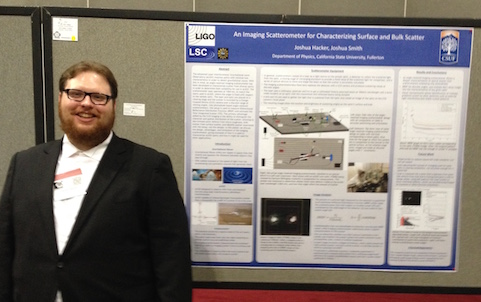
Josh Hacker presented in the graduate students section the poster "An imaging scatterometer for characterizing surface and bulk scatter." At CSUF, Josh continues to upgrade and document the imaging scatterometer.
Josh Smith organized and chaired a Scientific Symposium session, "Seeing and Hearing the Violent Universe with Gravitational Waves and Light" featuring an invited presentation by Jocelyn Read, entitled "Neutron stars and gravitational waves," along with talks by Caltech's Nicholas Smith and Larry Price. The session was attended by 40-50 scientists, mostly students, and ended with a lively Q&A session between the audience and a panel of the three speakers and student representative Daniel Vander-Hyde.
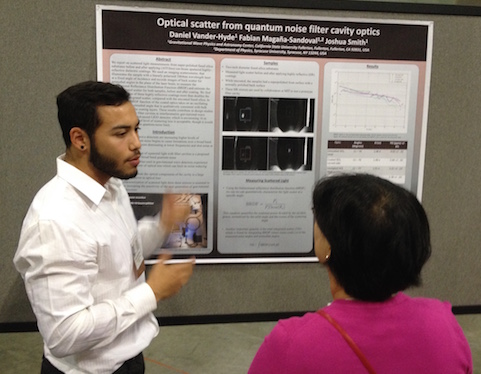
Geoffrey Lovelace and his GWPAC students did not attend SACNAS 2014, as they were busy assembling the greatly upgraded ORCA computing cluster in the CSUF data center.
GWPAC members are eagerly awaiting SACNAS 2015 in Washington DC!
Visiting Faculty and Postdoctoral Scholars Welcome
GWPAC welcomes visiting faculty members for short or extended visits and sabbaticals, and postdoctoral scholars such as Humboldt Fellows.
The Cal State Fullerton Gravitational-Wave Physics and Astronomy Center (GWPAC) was established to conduct research, education, and outreach in gravitational-wave astronomy, physics, and astrophysics. The center currently has three faculty members, one computing specialist, 8 master's students, and 15 undergraduates engaged in research, education and outreach related to gravitational-wave science.
GWPAC is facilitating collaboration among students, faculty members, visitors from around the world, and large external scientific collaborations. We also have strong local connections with gravitational-wave science at Caltech and with science education research at the Fullerton Catalyst Center.
For more information or to plan a visit, contact Joshua Smith at josmith@fullerton.edu
Syracuse-Fullerton Gravitational-Wave Bridge Program
Syracuse University Gravitational-Wave Group members Samantha Usman (undergraduate), Fabian Magaña-Sandoval (grad student), and Duncan Brown (faculty) visited GWPAC from May 19 to 23 2014. Their visit was part of the undergraduate to graduate bridge between the BS/MS program at Fullerton and the Ph.D. program in Syracuse.Throughout the week discussions focused on graduate school opportunities at Syracuse, collaborative research projects, and career mentoring. Students and faculty presented their research, worked together in small groups, and found time to go surfting and visit Disneyland.
Thank you very much Samantha, Fabian, and Duncan. We're looking forward to seeing you all again soon.
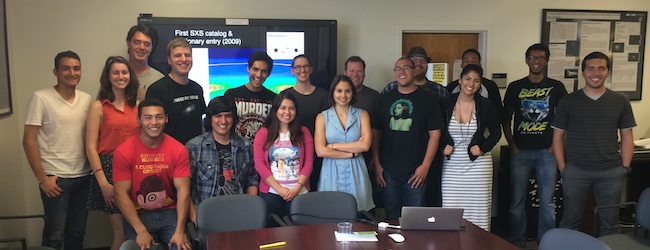
2013
Jocelyn Read and Geoffrey Lovelace awarded RCSA funding to study merging black holes and neutron stars
The Research Corporation for Science Advancement (RCSA) has awarded Jocelyn Read and Geoffrey Lovelace $75,000 for the two year project, "Developing a Numerical Injection Analysis Pipeline for Gravitational Waves from Merging Black Holes and Neutron Stars".
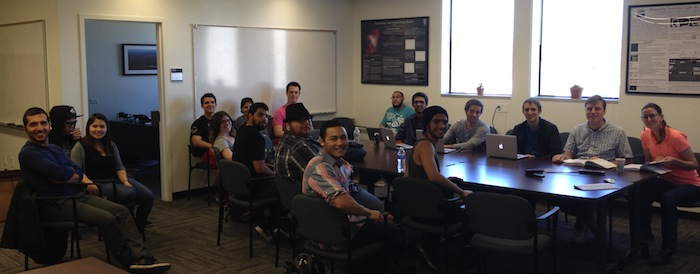
This Multi-Investigator Cottrell College Science Award, together with a $25,000 match from CSUF, will support research by Geoffrey, Jocelyn, and their students to compute and combine analytical and numerical gravitational waveforms of merging black holes and neutron stars. This combination of theoretical astrophysics and computational relativity will help maximize the scientific output of gravitational-wave detectors such as the Advanced Laser Interferometer Gravitational-wave Observatory (Advanced LIGO).
Jocelyn and Geoffrey joined CSUF in 2012, and have both developed active research programs. In addition to this RCSA support, Jocelyn and Geoffrey are funded by the NSF for the projects, "RUI: Dense Matter and Gravitational Waves: The Coalescence of Neutron Star Binaries" and "RUI: Numerical Simulations of Merging Black Holes and Neutron Stars," respectively. Together, they administer Orange county Relativity Cluster for Astronomy (ORCA) - a 240 core supercomputer located on the CSU Fullerton campus and used for gravitational-wave research.
Congratulations Geoffrey and Jocelyn!
Mission to Mars
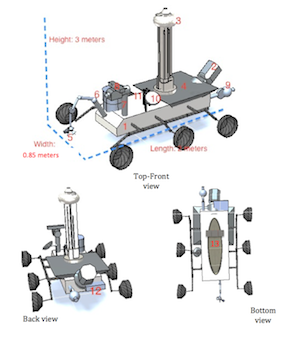
Based on his hypothetical Mars mission proposal "The Mars Subterranean Hydrothermal Exploration Rover - MaSHER," GWPAC researcher and Santiago Canyon College undergraduate Haroon Khan has been selected to visit the NASA Jet Propulsion Laboratory February 26-28th as part of the National Community College Aerospace Scholars (NCAS) program.
Haroon joined GWPAC in 2013 as a STEM^2 summer undergraduate researcher, studying, with Prof Geoffrey Lovelace, the mergers of binary-black-hole systems using computer simulations on the ORCA cluster.
Haroon's proposed mission involves landing the MaSHER rover in Mars' Valles Marineris canyon with the main goal of finding underground sources of water, gas, and or other potential life sustaining materials. Another objective of the mission is to test the effectiveness of harnessing wind on Mars as an energy source, using WindBelt technology. His proposal also included a 3-D design, launch and travel timeline, and approximate weight and cost. Haroon's mission proposal received a grade of 97/100, leading to his selection for the on-site portion of the program.
A poster summarizing Haroon's program is available.
Please help us in congratulating Haroon for this amazing accomplishment - and wish him best of luck for the next phase!
Profs Read and Smith attend GWPAW2013 in Pune, India
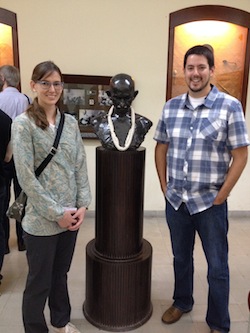
GWPAC and Department of Physics faculty members Jocelyn Read and Josh Smith attended the Gravitational Wave Physics and Astronomy Workshop (GWPAW) held December 17- 20, 2013 at the Inter-University Centre for Astronomy and Astrophysics (IUCAA) in Pune, India.
Both were invited to present on aspects of gravitational-wave astronomy, Jocelyn on"Measuring the Neutron Star Equation of State," and Josh on "Detector characterization to prepare for the first gravitational-wave detections."
The workshop was a gathering of 173 gravitational-wave scientists from around the world, and was held at a particularly exciting time, as India and the United States are strengthening their collaboration in gravitational-wave astronomy. We're looking forward to future Indo-Fullerton gravitaitonal-wave research.
Many thanks to the scientific and local organizing committees, particularly the meeting chair,Sukanta Bose (IUCAA & Washington State U.).
Jocelyn Read receives NSF funding for neutron-star astrophysics research
The National Science Foundation has awarded Jocelyn Read $126,000 in funding for the three-year research project "RUI: Dense Matter and Gravitational Waves: The Coalescence of Neutron Star Binaries."
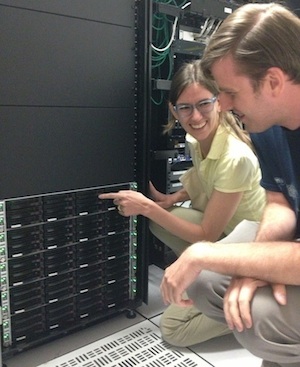
This award will support research by Jocelyn and her students to understand the effects on neutron star matter on the inspiral and merger of binary neutron-star systems. The results will be used by Read and other scientists in the LIGO Scientific Collaboration to perform more accurate searches for gravitational-waves and to better estimate the parameters (distances, orientations, component masses and spins) of the first gravitaional wave detections.Gravitational-wave measurements of neutron-star matter effects will potentially shine new light on the equation of state of matter above nuclear density, which is currently uncertain and a key research topic in both nuclear physics and astrophysics.
Jocelyn joined CSUF as an assistant professor of physics in 2012 and has kicked off a very active research program. She is currently mentoring a number of students on astrophysics projects, has co-authored several papers, and has collaborated with GWPAC faculty member Geoffrey Lovelace to build and administer the Orange county Relativity Cluster for Astronomy (ORCA) - a 240 core supercomputer located on the CSU Fullerton campus. With this NSF support, Jocelyn and her students will deepen their neutron-star research with the goal of helping Advanced LIGO and its international partners to make and interpret the first direct detections of gravitational waves from neutron star binaries.
Congratulations Jocelyn! We can't wait to see your results.
Adrian Avila-Alvarez presents research at SACNAS 2013
GWPAC member and junior physics major Adrian Avila-Alvarez and GWPAC director Josh Smith attended the 2013 SACNAS National Conference in San Antonio, TX October 3-6.
Adrian presented a poster on his CSUF research entitled, "Scattered Light Measurements for Advanced LIGO's Output Mode-Cleaner Mirrors." This work, funded by Josh's NSF CAREER award, is aimed at characterizing the optics that are used to improve the shot noise limit to sensitivity of the Advanced LIGO detectors.
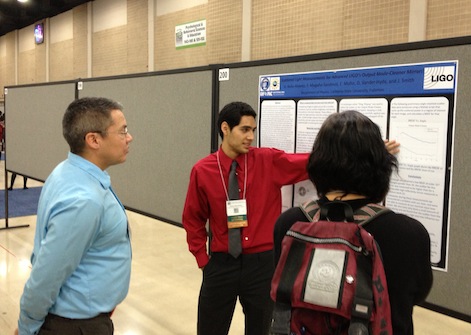
Josh helped to staff the LIGO (Laser Interferometer Gravitational-wave Observatory) outreach and recruitment booth.
Among the highlights of the meeting were an incredible keynote address by biologist and nobel laureate Dr. Martin Chalfie and an inspiring welcome from San Antonio mayor Julian Castro.
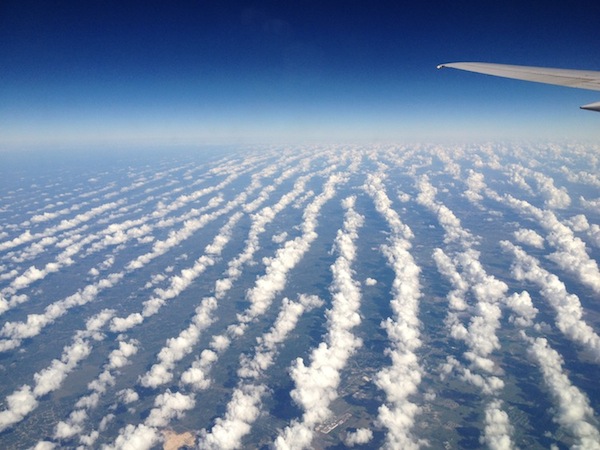
While en route, Josh and Adrian also witnessed a very strong set of cloud lines caused by gravity waves (not to be confused with gravitational waves!), an atmospheric phenomenon caused by air being pressed up over mountains and then oscillating like a pendulum forming clouds at each of its crests.
Adrian and Josh are already looking forward to SACNAS 2014 in LA!
Geoffrey Lovelace receives NSF funding for numerical relativity research
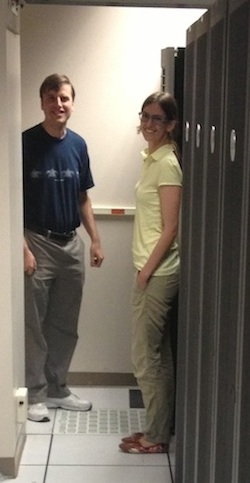
Geoffrey Lovelace has received $126,000 in funding from the National Science Foundation to support the three-year project "RUI: Numerical Simulations of Merging Black Holes and Neutron Stars."
As members of the Simulating Extreme Spacetimes Collaboration, Geoffrey and his students will use supercomputers and the Spectral Einstein Code (SpEC) to numerically solve Einstein's equations for binary systems of two black holes or a black hole and a neutron star, simulating the orbital parameters and the gravitational-waves that are emitted as the objects spiral in to each other and eventually merge. This research will provide information about how black holes and neutron stars behave under the most extreme conditions of strong gravity, orbital speeds, and black-hole spin. The gravitational waveforms that are produced will help extend the reach of LIGO and help us to learn as much as possible from the first detections of gravitational waves.
Geoffrey joined the CSUF department of physics as an Assistant Professor in 2012, and has had a very productive first year mentoring students in research, and publishing several papers, and together with fellow GWPAC faculty member Jocelyn Read building the Orange county Relativity Cluster for Astronomy (ORCA), a 240 core supercomputer at CSU Fullerton. This NSF funding will allow Geoffrey and his students to expand their already excellent research.
Congratulations Geoffrey!
Summer 2013 research kicks off
The Gravitational-Wave Physics and Astronomy Center at CSUF, which opened in September 2012, has kicked off its first summer of research with a grand total of 22 students, faculty, and staff. The center brings together three gravitational-wave research groups led by Jocelyn Read, Geoffrey Lovelace, and Josh Smith, focusing on neutron-star astrophysics, numerical-relativity simulations, and LIGO detector characterization, respectively. Along with their research project work, the center members meet as a group for two hours each week. We're starting the summer with a three-week "crash course" on the fundamentals of gravitational-wave science, and will then transition to more detailed research reports from GWPAC members.
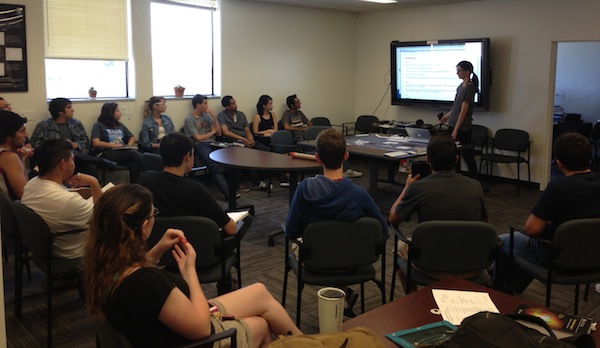
The 2013 GWPAC summer group members are:
Read group:
Jocelyn Read - CSUF Faculty
April Hankins - CSUF Master's Student
Veronica Lockett-Ruiz - CSUF Master's Student (Co-with Smith group)
Ivan Ozaeta - CSUF Master's Student
Eric Flynn - CSUF Undergraduate
Susan Vong - STEM^2 Student and Undergraduate at Citrus College
Brendan Green - Troy High School Student
Lovelace group:
Geoffrey Lovelace - CSUF Faculty
Evan Foley - CSUF Master's Student
Ivan Blanco - STEM^2 Student and Undergraduate at Santiago Canyon College
Haroon Khan - STEM^2 Student and Undergraduate at Santiago Canyon College
Nicholas Trank - Troy High School Student
Smith group:
Josh Smith - CSUF Faculty
Joseph Areeda - CSUF Staff
Gabriel Islas - CSUF Master's Student
Fabian Magaña-Sandoval - CSUF Master's Student
Cinthia Padilla - CSUF Graduate
Gabriela Serna - CSUF Graduate
Adrian Avila-Alvarez - CSUF Undergraduate
Erik Muniz - STEM^2 Student and Undergraduate at Cypress College
Matthew Russell - STEM^2 Student and Undergraduate at Santiago Canyon College
Josh Smith receives NSF Career award
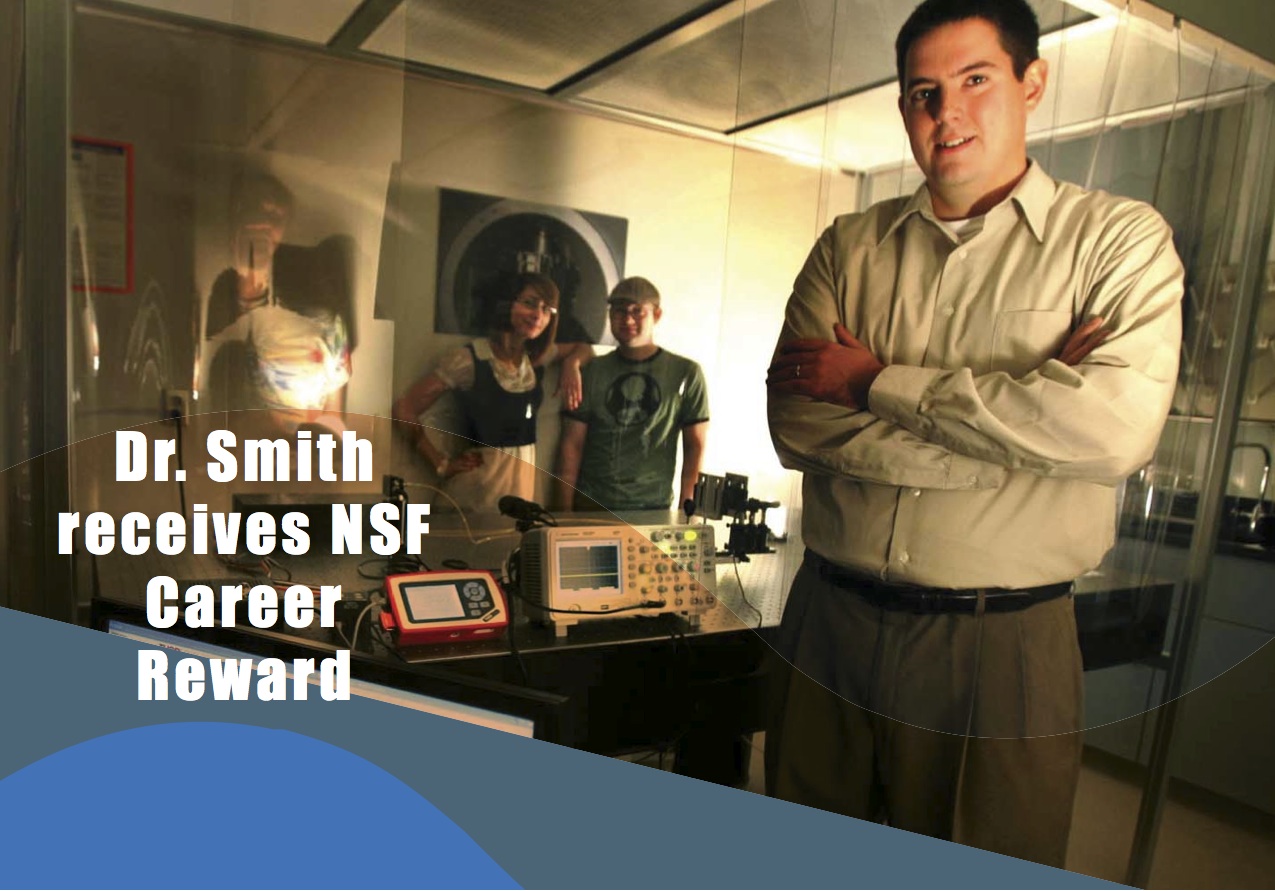
Josh Smith, director of GWPAC, has received an NSF Career award for his proposed project "Gravitational-wave Detector Characterization and Science Education in the Advanced LIGO Era." This award will provide support over a five-year period for an integrated research and education program in gravitaitonal-wave science for Josh and his students.
There will be a reception to honor Josh on Wednesday, March 27 at 3:30 PM in MH141; refreshments will be provided.
Simulating black hole mergers
Led by new GWPAC faculty member Geoffrey Lovelace, CSUF students Evan Foley, Matt Giesler, and Iván Ozaeta have begun learning to use the Spectral Einstein Code (SpEC) to simulate colliding black holes.
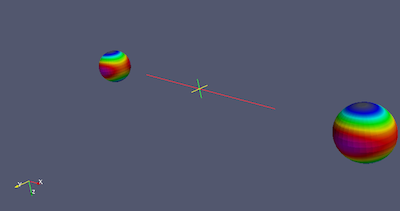
Initial data for two spinning black holes that will fall together from rest and collide head-on. Each hole spins about its center on an axis parallel to the green line. The black-hole horizons are shown, colored by their shape: they are not spherical but bulge in the red regions and are squashed in the blue regions. Figure courtesy Evan Foley.
Colliding black holes are among the most promising sources of gravitational waves for detectors like LIGO (the Laser Interferometer Gravitational-Wave Observatory). Numerical simulations are the only known way to predict the gravitational waves emitted when two black holes spiral together and merge, leaving behind a final, larger black hole.
For their first test problem, Foley, Giesler, and Ozaeta are simulating the simpler case of two spinning black holes that start from rest and collide head-on. So far, each student has started a test simulation, and they already have partial results that they are analyzing and visualizing. The experience they gain with these test simulations will lead them to future research exploring the inspiral and merger of spinning black holes in configurations that have never before been simulated.
The gravitational waves predicted by these simulations will then contribute to a large catalog of waves from colliding black holes that LIGO might observe; this catalog will help LIGO scientists to find actual gravitational-wave signals from colliding black holes, which will be hidden within noisy detector data.
Lovelace and Read visit KITP
GWPAC faculty members Geoffrey Lovelace and Jocelyn Read spent the week of July 30th at the Kavli Institute for Theoretical Physics in Santa Barbara. They were there to attend the KITP conference "Rattle and Shine: Gravitational Wave and Electromagnetic Studies of Compact Binary Mergers." The conference brought together astronomers studying gravitational-wave or electromagnetic (optical, radio, x-ray and gamma-ray) signals, to discuss the inspiral and merger physics of compact binary systems: pairs of neutron stars or black holes that radiate gravitational waves until they collide.
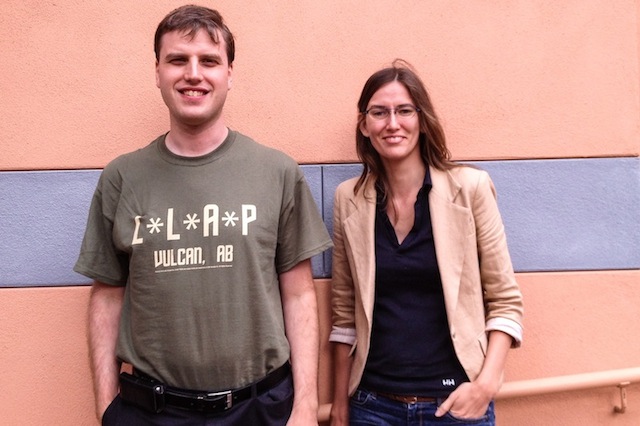
On Tuesday morning, Geoffrey gave an invited talk on "Numerical Simulations of Binary Black Holes in the Presence of Spins," and on Wednesday morning, Jocelyn gave an invited talk on "Gravitational-wave Astrophysics with Systems Containing Matter." The talks, posters, and extensive discussions brought together experts from diverse fields, sparking new ideas for research at CSUF.
Jocelyn also realized that she had lost whatever bowling skills she may once have had, but eventually managed to hit a pin in an evening game with other conference attendees. Geoffrey was reintroduced to the joy of driving in Los Angeles traffic.
